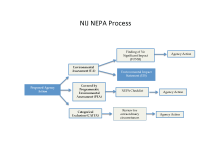This page is intended to provide you, the NIJ Applicant, with more information about the NEPA Process and the associated requirements that may apply to your project.
The National Environmental Policy Act (NEPA) was signed into law in 1970 to promote efforts that prevent or eliminate damage to the environment. [42 U.S. Code § 4321- 4347]. NEPA requires that prior to funding, authorizing, or implementing an action, federal agencies consider the effects that their proposed action may have on the environment[1] and the related social and economic effects, as early as possible in any given decision-making process.
NEPA is typically referred to as an “umbrella” statute because it encourages agencies to incorporate other environmental and historic preservation requirements into one analysis for a streamlined decision-making process. To view some of these other laws and requirements as they apply to NIJ’s NEPA compliance, see NIJ Grants Program Checklist and Instructions.
NIJ NEPA Regulations and Implementation
NEPA recognizes that the range of federal actions that could cause environmental harm is broad, and so it applies to the majority of federal actions including policies, plans, and projects including projects that use federal funding such as NIJ grants.
The Office of Justice Programs’ NEPA regulations can be found at Appendix D to 28 CFR Part 61 – Office of Justice Assistance, Research, and Statistics Procedures Relating to the Implementation of the National Environmental Policy Act. These are the regulations that apply to NIJ. NEPA requires that NIJ study the potential environmental impacts of proposed agency actions prior to commencing the action. Applicants are required to support NIJ during the NEPA process by providing information about the proposed action, activity area, and resources that may be impacted by the proposed activity.
NIJ will comply with NEPA for a activity or action by evaluating the environmental impacts of the action in one of three levels of analysis (discussed below): Categorical Exclusion, Environmental Assessment, or Environmental Impact Statement. After review of your project application, NIJ will determine which type of NEPA analysis is appropriate for the activity.
Categorical Exclusion (CATEX)
A Categorical Exclusion (CATEX) is an action that an agency has determined does not normally have a significant impact on the human environment. If a federal agency knows a particular type of action will not generate a significant environmental impact, based on agency experience, then the agency may elect to categorically exclude the action from further environmental review. Agencies generate agency-specific lists of CATEXs based on experience and these lists are formalized through the regulatory process. Agencies can only use a CATEX if it is listed in their NEPA implementing procedures.
Environmental Assessment (EA)/Finding of No Significant Impact (FONSI)/ Programmatic Environmental Assessment (PEA)
An EA is a brief and concise analysis completed by the agency to determine if an activity will have a significant impact on the environment. If, after analysis, no significant impacts are found or mitigation can avoid or minimize the impacts below the level of significance, NIJ can issue a Finding of No Significant Impact (FONSI). However, if significant impacts are likely, NIJ will need to issue a Notice of Intent to prepare an Environmental Impact Statement (EIS).
In 2010, NIJ completed a Programmatic Environmental Assessment (PEA) which analyzed, on a larger -programmatic- scale, the potential environmental impacts of implementing many of the projects funded by NIJ. By using a programmatic approach, NIJ evaluated the common types of actions that are routinely funded by NIJ.
Environmental Impact Statement (EIS)/Record of Decision (ROD)
An EIS is a more extensive review of impacts that analyzes and documents the impact the action and reasonable alternatives will have on the environment. Following the analysis and a mandatory 45-day public comment period, a Record of Decision is prepared which outlines the necessary actions that must be taken by the agency and the decision as to whether or not to proceed with the proposal or one of the alternatives considered in the analysis.
Note
[note 1] In the context of NEPA, “environment” includes natural and historic resources, as well as human impacts such as socio-economic, visual, and noise impacts that could be of concern to local communities.


